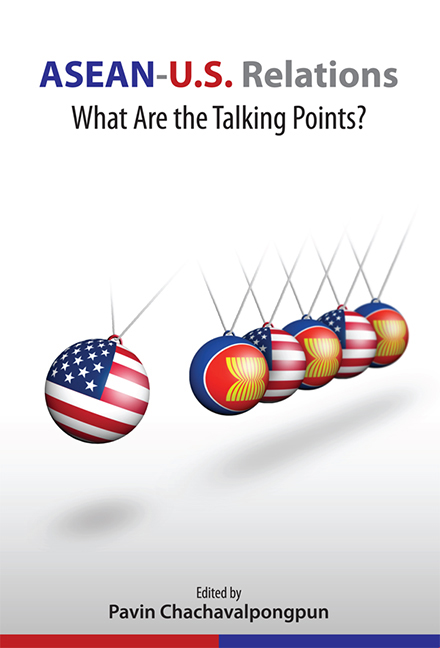Book contents
- Frontmatter
- Contents
- List of Tables and Figures
- Preface
- Contributors
- List of Abbreviations
- OVERVIEW
- QUINTESSENTIAL ISSUES
- 6 A New Era in the Long-Standing U.S.-ASEAN Relationship
- 7 Maritime Security in Southeast Asia and the United States
- 8 ASEAN's View on the U.S. Military Role in the Region
- 9 United States–China Relations
- 10 Shift in U.S. Policy towards Myanmar
- 11 United States Assistance to ASEAN through the ADVANCE Programme
- 12 Conclusion
- Index
6 - A New Era in the Long-Standing U.S.-ASEAN Relationship
from QUINTESSENTIAL ISSUES
Published online by Cambridge University Press: 21 October 2015
- Frontmatter
- Contents
- List of Tables and Figures
- Preface
- Contributors
- List of Abbreviations
- OVERVIEW
- QUINTESSENTIAL ISSUES
- 6 A New Era in the Long-Standing U.S.-ASEAN Relationship
- 7 Maritime Security in Southeast Asia and the United States
- 8 ASEAN's View on the U.S. Military Role in the Region
- 9 United States–China Relations
- 10 Shift in U.S. Policy towards Myanmar
- 11 United States Assistance to ASEAN through the ADVANCE Programme
- 12 Conclusion
- Index
Summary
The United States and the Association of Southeast Asian Nations (ASEAN) have entered a new era in our relations. I would like to discuss the current relationship and what we hope that relationship will look like in the coming years. I do not want to emphasize too much our past relations with ASEAN, but it is important to devote some lines to recounting how long-standing our commitment to ASEAN has been.
I want to emphasize three points that came out of what President Obama said to the asean leaders when he met with them in Singapore in November 2009. First, the President reminded people both in his speech in Tokyo and in his Singapore meeting that the United States is a Pacific power, and we have been committed to and engaged with Southeast Asia in a serious way for decades. In recent years, there has been a little buzz that even those of us in Washington could hear from ten thousand miles away, expressing some concerns that the United States was distracted or perhaps not fully committed to asean and to Southeast Asia. And it was a source of some frustration for all of us working in asean, because we felt we have actually been quite active. We can debate on that point, but the important thing is that the perception did exist that the United States was not as engaged as it should be.
The ASEAN–United States Dialogue relationship began thirtytwo years ago, in 1977, during a very different time globally. Our early relations with ASEAN were focused on economics, trade, and development. It was not until the 11th ASEAN–U.S. Dialogue meeting in Brunei in 1993 that we even had any political issues for discussion on our formal dialogue agenda. Then, in 2002, we established the ASEAN Cooperation Plan, and Secretary of State Colin Powell signed the ASEAN–United States of America Joint Declaration for Cooperation to Combat International Terrorism. By then, the world had changed, and ASEAN–U.S. relations were changing in response. Our relations have grown dramatically since then. ASEAN leaders and President Bush issued the Joint Vision Statement in 2005, creating the Enhanced Partnership, and ASEAN foreign ministers and Secretary of State Condoleezza Rice signed the plan of action to implement that statement in 2006. We also signed the Trade and Investment Framework Arrangement that year.
- Type
- Chapter
- Information
- ASEAN-U.S. RelationsWhat Are the Talking Points?, pp. 27 - 38Publisher: ISEAS–Yusof Ishak InstitutePrint publication year: 2011



